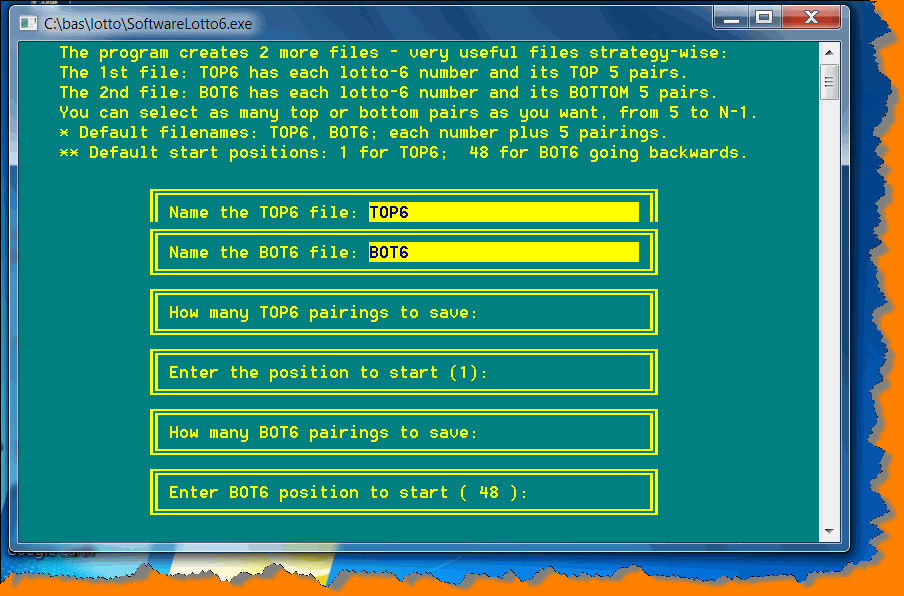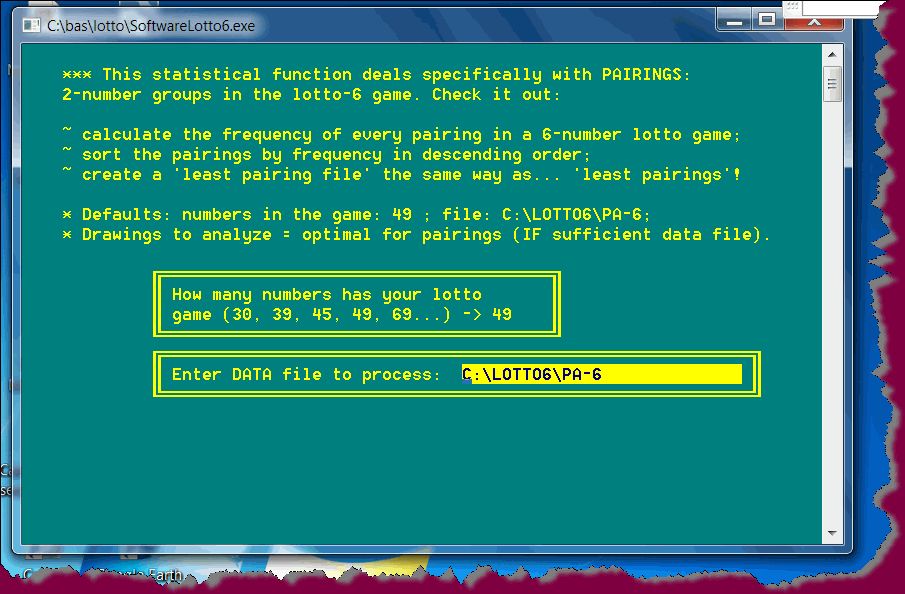
Most Powerful Lottery Strategy? Pairs, Pairings, Frequency, Lotto Wonder Grid
By Ion Saliu, ★ Founder of Lotto Mathematics



Written on March 24, 2001 - and later...
The Wonder Grid lottery strategy is based on two elements:
• Selecting a key number follows the procedures presented on the Winning Lottery Strategy page (LottoWin.htm – see link in the Resources section). There is no denial at this step. Each and every lotto number repeats after a number of drawings less than its median in at least 50% of the cases. FFG explains in mathematical terms such behavior of lottery numbers. The formula is also validated by real lottery drawings. I haven't heard of any report to the contrary, in any lottery. I am convinced now FFG will not be contradicted in this regard, ever.
Let's take the case of the lotto 6/49 game, the most common worldwide. The median is 6 (use my probability software SuperFormula to do the calculations for a 50% degree of certainty DC). We need software to plot the skips for each lotto number. A skip shows how many drawings a number waits between hits. My comprehensive lottery software MDIEditor Lotto WE and Super Utilities (main menu of Bright / Ultimate Software) do the best job at charting the lotto skips. The skips will look like this:
Number: 8
Skips: 4 11 20 1 22 6 4 7 3 8 4 3 2 6 0 12 13 0 6 1 3 1...
Median Skip: 4
Number: 9
Skips: 5 5 2 0 35 1 1 4 0 23 1 11 16 5 0 17 21 11 4 3 8
Median Skip: 5
If we add up the skips 0, 1, 2, 3, 4, 5 — for any number — the sum will represent at least 50% of all cases. (The case above shows actual data in a 6/69 lotto case, where the median is 8). Calculating the probability to selecting a lotto number with a skip below the median involves two steps. There is a 50% chance (or 1/2) that a lotto number will repeat after an amount of drawings lower than the median. But the median takes 6 values, from 0 to 5. The simultaneous probability of the two events is 1/2 x 1/6 = 1/12 (8.3%). We should be successful every 12 tries (drawings) in picking a favorite lotto 6/49 number. Read all mathematical foundation: FFG Median, Skips, Lottery, Lotto Filtering, Probability, Odds, Jackpot.
So far, this is the strongest part of the potential killer lotto strategy, probabilistically speaking.
•• The second part of the strategy is newer in my research. It is based on the pairings of the lotto numbers. Given a range of drawings, each lotto number shows a clear bias towards being drawn with the rest of the lotto numbers. The newest version of my Super Utilities calculates the frequencies of all lotto pairings for every lotto number. It is a major component of Bright6 (2011), definitely the most powerful collection of lotto software applications. The following pairing report was done by function F = Frequency Reports by Lotto Number.

The report looks like this:
Number: 1 Hits: 19 ( 9.5 %)
With #: 8 16 30 22 25 14 31 32 42 27 29 17 21 15 33 35 36 ...
Hits: 4 4 4 3 3 3 3 3 3 2 2 2 2 2 2 2 2 ...
Pairs total: 95
Number: 2 Hits: 23 ( 11.5 %)
With #: 36 40 6 48 68 24 25 7 9 42 11 50 61 6...
Hits: 6 6 4 4 4 3 3 3 3 3 3 3 3 3 ...
Pairs total: 115
...
Number: 69 Hits: 18 ( 9 %)
With #: 19 51 63 3 22 26 36 40 6 9 64 29 34...
Hits: 4 4 4 3 3 3 3 3 3 3 3 2 2 2 2...
Pairs total: 90
I know the pair frequencies are based on FFG, although I haven't done an analysis as thorough as in Step 1.
The top 10% of the pairings represents 25% of total frequencies for each number. The top is defined as the most frequent part in a pairing string (starting from left to right). In the case above (still a lotto 6/69 game) the top 10% means the first 7 pairs (10% of 69 is approximately 7). The first 10% pairs for lotto number 1 add-up to 24 (25.3% of all 95 cases for that lotto number). 4+4+4+3+ 3+ 3+ 3 = 24.
Conversely, the bottom 10% pairs sum-up to 0 (zero).
The top 25% of the pairings represents 50% of total frequencies for each number. That is, the 25% segment of the most frequent pairs account for 50% of the entire pairing frequency for any given lotto number.
The top 50% of the pairings represents 75% of total frequencies for each number. That is, the first half of the pairs (from left to right) accounts for 75% of the entire pairing frequency for any given lotto number.
The other type of pairing reporting in Super Utilities can be performed by function 2 = Lotto Pairs Rundown.

Again, I repeat the very important point here. My analysis of the lotto pairings is not as thorough as other domains of my gambling mathematics. But this is an open debate and we should be able to find the fault, if it exists. So, I assume that the pairing percentages above hold true for any lotto game, at any given point in a lotto history. Based on the premise, I decide on the following lottery wonder grid strategy:
In a hypothetical case, I will play number 1, since it shows as the last skip a value between 0 and 5. For a lotto 6/49 game, I will also play the most frequent 12 pairs (25% of the remaining 48 lotto numbers). Lotto number 1 comes out with its top 25% pairs in 50% of its appearances. The chance is 1/2 that the lotto number will come out with such pairings – WHEN it hits!
Every combination I play will contain the number 1 (the favorite). The remaining 5 numbers will consist of combinations of the 12 lotto numbers in the most frequent 25% pairs. Total combinations of 12 taken 5 at a time: C(12,5) = 792. The combined probability to hit the jackpot is 1/12 x 1/2 = 1/24.
It sounds extraordinary: the chance is 1 in 24 to win the lotto jackpot with 792 combinations. 792 x 24 = 19008. For a total cost of $19,008 it is possible to win the one million dollar jackpot! Actually, I saw such lotto combinations – containing a favorite number plus 5 numbers from its top 25% pairs. Checking for winning lotto numbers this way is a little trickier. First, the software should break down the top pairs in groups of 5, and then add the favorite number to each combination. Then, it should check the results against real drawings.
Curiously, this strategy does NOT work with static lotto wheels. Instead of playing all possible combinations of 5, we may think of wheeling the 12 most frequent pairs. Let's say the best 3 of 5 12-number static wheel amounts to 6 combinations. 24 x 6 = 144 combinations, while the 3rd prize is lower than $144. Even playing a 4-combination 3 of 5 wheel makes no sense at all. 24 x 4 = 96, probably still below the prize! One more reason why playing static lotto wheels is a no-no.
This is an open debate. I hope there will be several worthy contributions. Somebody made a contribution already, before I posted this lotto strategy. See the post “Eliminate more than one of the worst lotto pairings! – Ramanujan Mathematician”.
There is another category. There are those who don't want to make their "killer" lottery strategies public. I have received several requests to take a look at or try to improve lottery or gambling systems. The requests were private and their authors did not want to make public their ideas. They have a point, but it's not a strong point. I know how humans function. Humans have progressed, in great part, because they make public their efforts. Effort here has a generalized meaning. That's not pure generosity. We make our efforts public because we expect positive consequences that serve us.
The Fear-Survival system is selfish, to be sure, even when it shows signs of unselfishness. Quoting from a Beatles song: ”You take what you make". Speaking from my personal experience. Don't more than a few computing beasts consider me nuts because I make public my gambling and lottery systems?! So, what? I am not at a loss. On the contrary, I have gained more knowledge and improved my mathematical systems to higher degrees. I feel a force inside that pushes out many of my ideas. The force has come up with something new and worthier. I just want more free space in my mind. Believe me, you'll come up with even better ideas after you make public some of your private thoughts.

MDIEditor Lotto WE: Lottery Software Manual, Book, ebook, Help.
~ Also applicable to LotWon lottery, lotto software; plus Powerball/Mega Millions, Euromillions.
Follow Ups

